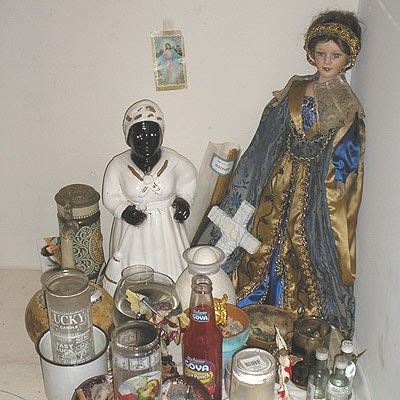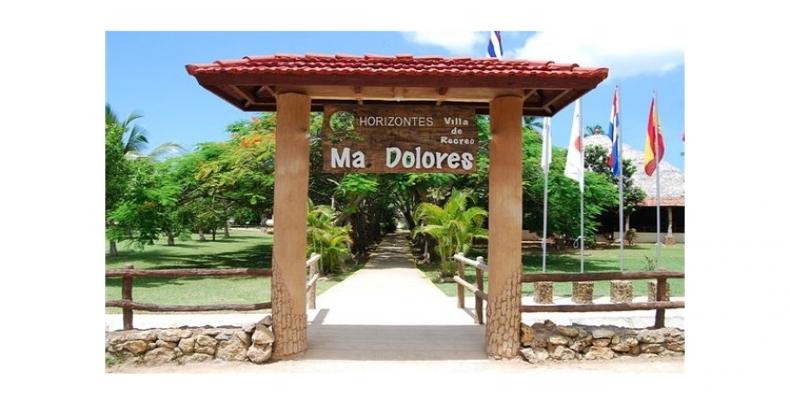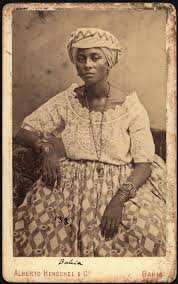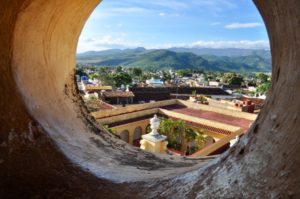 HISTORIA DE “LA BRUJA DE CABARNAO”, “LA POZA DE Ma DOLORES” IZNAGA EN TRINIDAD, CUBA.
HISTORIA DE “LA BRUJA DE CABARNAO”, “LA POZA DE Ma DOLORES” IZNAGA EN TRINIDAD, CUBA.
Guarda Trinidad en Cuba junto a sus añejas calles, mansiones y palacetes un sinfín de leyendas engarzadas con la realidad, como la de María Dolores Iznaga, con fama de curar todo tipo de padecimientos.
La Poza Ma Dolores, cuyas aguas en tiempos remotos fueron consideradas milagrosas, recibió el nombre por esa negra esclava que por su apellido es probable perteneciera a la acaudalada familia de los Iznaga, dueños de prósperos ingenios azucareros.
Según datos históricos que se mezclan entre el mito a la realidad, Ma Dolores disfrutó de ciertos privilegios por parte de sus amos, como que le concedieran la libertad y un pequeño terreno donde pasar su vejez en las riberas del arroyo Cabarnao. Cerca del lugar adonde fue a vivir estaba dicha poza o manantial, que con el pasar de los años tomaría su nombre, y cuyas aguas empezó a utilizar con fines curativos. En un inicio las emplearía con la población negra de los alrededores para luego extender sus servicios -hasta los relativos a los del alma y las pasiones- a las personas blancas.
Esto hace pensar que de cierto modo las aguas surtían algún efecto sanador cuando incluso gente con determinada cultura o renuentes a usar métodos tradicionales acudieron a esos remedios. No obstante las personas iban a visitarla al lugar donde vivía más por sus supuestos poderes sobrenaturales que por los beneficios de las aguas del manantial, mientras también aseguran aplicaba saliva en su método curativo.
En la narración del Libro ‘Recuerdos del tiempo” su autor Narra Emilio Sánchez (1916) cuenta que para entonces las autoridades coloniales creyeron que el lugar era un centro de conspiración y ‘el 15 de mayo de 1875 ingresaron en la cárcel Ma Dolores y trece individuos más’. Era la época de la llamada Guerra de los Diez Años (1868-1878) que libraban los patriotas cubanos -conocidos como mambises- contra el yugo del colonialismo español, en aras de lograr la independencia.
Cualquier mínima sospecha de ayuda o contribución a la causa independentista se pagaba con la muerte, el trabajo forzado o el destierro; ejemplos hay muchos en la historiografía cubana y aunque en el registro realizado en el humilde bohío de la negra gangá no encontraron nada comprometedor, solo plumas de lechuza y huesos de animales, entre otros objetos, así como ‘un altar donde figuraban todos los santos’, fue juzgada por el delito de infidencia. Aun asi “las autoridades españolas, inspiradas seguramente por un ruin delator, conocían los secretos que encerraba aquel pobre bohío’, indica Sánchez y Sánchez fue condenada a la máxima pena.
Cuentan que cuando le dieron a conocer la sentencia Ma Dolores exclamó: A mí no va a matá… Los angelito me viene a bucá y me va llevá…’.
Trágicos y coincidentes sucesos acaecidos en la ciudad fueron achacados entonces a esta pobre mujer, mientras la población continuaba exigiendo y rogando por la liberación de Ma Dolores, entre ellos negros esclavos que invocaban a sus dioses en la lengua natal.
Cuando todo estaba listo para terminar con la vida de la mujer, un mensajero a caballo trajo consigo la orden de suspender la ejecución y el hecho contribuyó a que creciera el fervor por las mágicas virtudes de Ma Dolores, por tanto su fama y la de la poza aumentaron. Señala Sánchez y Sánchez que ‘se vio venir a todo galope, en brioso corcel, un oficial español, alta la diestra y en ella portaba un pliego’ y que repetía incesantemente Perdón!, Perdón para el reo!’. El autor considera que en efecto Ma Dolores resultó una eficaz auxiliar de los cubanos que luchaban contra el colonialismo español y al conmutarse la pena de muerte por la de destierro el 14 de marzo de 1876 fue conducida a La Habana, a fin de cumplir la condena.
Incluso después de morir la mujer, a quien se le conoció asimismo como ‘la Bruja de Cabarnao’, la poza siguió siendo lugar de reunión para muchas personas en busca de cura a sus padecimientos. Aseguran que un pequeño altar a la Virgen de la Caridad, patrona de Cuba, fue construido por algunos devotos en las márgenes del arroyo.
Otrora, en particular los Viernes Santos, una extensa procesión salía desde Trinidad y sus alrededores y desde Magua hasta la poza de Ma Dolores, pero con el transcurso de los años fue perdiendo poco a poco la popularidad que obtuviera épocas atrás.
Han pasado más de 150 años y la tradición mantiene vivo el recuerdo de María Dolores Iznaga de Cabarnao.
 HISTORY OF “LA BRUJA DE CABARNAO”, “LA POZA DE MA DOLORES” IZNAGA IN TRINIDAD, CUBA.
HISTORY OF “LA BRUJA DE CABARNAO”, “LA POZA DE MA DOLORES” IZNAGA IN TRINIDAD, CUBA.
Keeps Trinidad in Cuba its old streets, mansions and endless legends linked to reality, such as Maria Dolores Iznaga, reputed to cure all kinds of ailments.
‘La Poza Ma Dolores’, whose waters in ancient times were considered miraculous, was named after that black slave who by her surname is likely belonged to the wealthy family of Iznaga, owners of prosperous sugar mills.
According to historical data that mix between myth and reality, Ma Dolores enjoyed certain privileges on the part of her masters, such as granting her freedom and a small plot of land to spend her old age on the banks of the Cabarnao stream. Near the place where he went to live was said well or spring, which with the passing of years would take his name, and whose waters began to be used for healing purposes. Initially, he would use them with the surrounding black population to later extend his services – even those related to the soul and the passions – to white people.
This suggests that in a certain way the waters had some healing effect when even people with a certain culture or reluctance to use traditional methods resorted to these remedies. However people went to visit the place where he lived more for his supposed supernatural powers than for the benefits of the waters of the spring, while also ensuring saliva applied in his healing method.
In the narration of the book ‘Memories of Time’ its author Narra Emilio Sánchez (1916) tells that by then the colonial authorities believed that the place was a center of conspiracy and ‘on May 15, 1875 entered Ma Dolores jail and thirteen more individuals. “It was the time of the so-called Ten Years War (1868-1878) waged by Cuban patriots – known as mambises – against the yoke of Spanish colonialism, for the sake of achieving independence.
Any minimal suspicion of help or contribution to the independence cause was paid with death, forced labor or exile; there are many examples in the Cuban historiography and although in the record made in the humble hut of the black gangá they found nothing compromising, only owl feathers and animal bones, among other objects, as well as ‘an altar where all the saints figured’ , was judged for the crime of infidelity. Even so, “the Spanish authorities, inspired by a ruinous informer, knew the secrets that this poor bohio contained,” says Sánchez and Sánchez was sentenced to the maximum penalty.
They say that when they told him about the sentence, Ma Dolores exclaimed: “I’m not going to kill … The little angel comes to me and I’m going to take …”.
Tragic and coincidental events in the city were then attributed to this poor woman, while the population continued to demand and beg for the release of Ma Dolores, among them black slaves who invoked their gods in their native language.
When everything was ready to end the life of the woman, a messenger on horseback brought the order to suspend the execution and the fact contributed to the fervor grew by the magical virtues of Ma Dolores, therefore his fame and that of the well they increased. Sanchez and Sanchez points out that “he saw himself coming at full gallop, on a spirited steed, a Spanish officer, high on the right and carrying a sheet on her,” and who repeated incessantly, “Sorry, sorry for the prisoner!” The author considers that in fact Ma Dolores was an effective auxiliary to the Cubans who were fighting against Spanish colonialism and when the death penalty was commuted to the one of exile on March 14, 1876, she was taken to Havana, in order to serve her sentence. .
Even after the death of the woman, who was also known as ‘the Witch of Cabarnao’, the pool remained a meeting place for many people in search of a cure for their suffering. They claim that a small altar to the Virgin of Charity, patron saint of Cuba, was built by some devotees on the banks of the stream.
Once, in particular on Holy Friday, an extensive procession left from Trinidad and its surroundings and from Magua to the pool of Ma Dolores, but over the years was losing little by little the popularity that was obtained in the past.
More than 150 years have passed and the tradition keeps alive the memory of María Dolores Iznaga de Cabarnao.
Agencies/ PL/ Mayra Pardillo/ Internet Photos/ Arnoldo Varona/ www.TheCubanHistory.com
THE CUBAN HISTORY, HOLLYWOOD.







